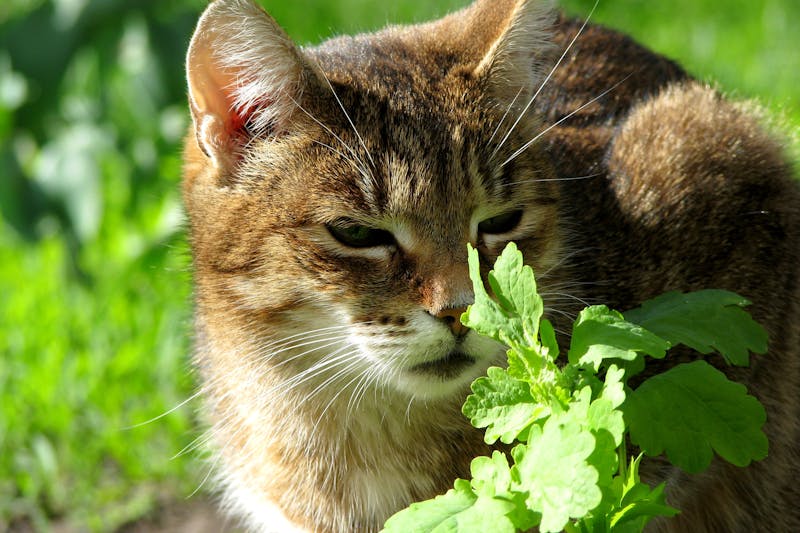Cats are drawn to catnip because it contains a compound called nepetalactone, which triggers a temporary euphoric response when they smell it. This chemical interacts with receptors in a cat’s nose, stimulating their sensory neurons and causing behaviors such as rolling, rubbing, and playful excitement. Not all cats react, though, as sensitivity to catnip is inherited genetically.
The effects of catnip vary among individual cats, with some becoming energetic and others calm or sleepy. Understanding why cats respond this way can help owners use catnip responsibly to enhance their pet’s playtime and well-being.
Understanding Catnip and Its Active Compounds
Catnip is a plant with specific chemical compounds that produce distinct physical and behavioral effects in many cats. These compounds interact with feline neurological systems, explaining why some cats show strong reactions while others do not. The plant’s composition and its physiological impact are key to understanding this phenomenon.
What Is Catnip?
Catnip, or Nepeta cataria, is a member of the mint family. It features heart-shaped leaves with serrated edges and small white or purple flowers. While it appears as a common herb, catnip holds unique significance due to how its chemical compounds affect cats.
The plant is available fresh, dried, or in commercial forms such as toys and treats. Its cultivation is simple, which makes it readily accessible to cat owners seeking to engage or calm their pets.
Chemical Components of Catnip
The primary active ingredient in catnip is nepetalactone, an organic compound responsible for the typical euphoric effects in cats. Nepetalactone binds to sensory neurons in the cat’s nose and stimulates neurological pathways associated with play and excitement.
Catnip also contains additional substances like terpenoids, iridoids, and essential oils including neral and geranial. These elements contribute to its aroma and may have mild calming or stress-relieving effects when ingested.
| Compound | Effect | Role |
|---|---|---|
| Nepetalactone | Euphoric stimulation | Triggers play and rolling |
| Terpenoids | Fragrance components | Enhances scent profile |
| Neral, Geranial | Mild sedation | Calms and reduces anxiety |
How Catnip Affects Feline Biology
Nepetalactone activates receptors in the cat’s olfactory system, causing temporary behavioral changes such as rolling, pawing, and increased playfulness. These responses are inherited genetically, affecting approximately 50-70% of cats.
When ingested, catnip’s chemical compounds can act as a mild sedative, promoting relaxation instead of excitement. This dual effect explains why catnip is used both for play stimulation and anxiety reduction.
Neurologically, the response to catnip mimics signals related to mating behaviors but without actual reproduction. The interaction is specific and does not induce addiction or harm, making catnip a safe, temporary behavioral stimulant for many cats.
Why Cats Are Attracted to Catnip
Catnip affects cats through a specific chemical that triggers a sensory response. This reaction depends on how cats detect the substance and varies due to genetic differences. These factors combine to explain why some cats respond strongly while others show no interest.
The Role of Nepetalactone
Nepetalactone is the main compound in catnip responsible for its effects. When cats inhale or come into contact with nepetalactone, it binds to receptors in their nasal tissue. This interaction stimulates sensory neurons that send signals to the brain’s olfactory bulb.
The stimulation activates areas linked to behavior and emotion. As a result, cats may display behaviors like rolling, rubbing, and playful excitement. The response to nepetalactone is temporary, typically lasting around 10 minutes before cats become temporarily immune.
Nepetalactone is unique to plants in the Nepeta genus, and it acts as a natural insect repellent. This chemical is what drives the distinctive reactions catnip provokes in sensitive cats.
How Cats Sense Catnip
Cats detect catnip primarily through their sense of smell. Specialized receptors in their nasal passages recognize nepetalactone molecules. Once detected, these receptors trigger a chain reaction in the brain that influences behavior.
The response is more than just scent detection; it involves stimulation of the vomeronasal organ, also known as Jacobson’s organ. This organ processes pheromone-like signals and plays a key role in social and reproductive behaviors, which explains why catnip can induce mating-like actions.
Unlike humans, cats have a highly developed olfactory system, making them particularly sensitive to specific plant compounds. This ability allows them to experience the behavioral effects that catnip creates.
Genetic Factors Influencing Response
Not all cats react to catnip due to genetic variation. Sensitivity to catnip is inherited as a dominant trait, meaning only cats with the gene respond. Approximately 50-75% of cats carry this gene and show a reaction.
Kittens and older cats are less likely to respond, implying age also influences sensitivity. Cats without the gene appear indifferent because their receptors do not recognize nepetalactone.
This genetic aspect explains why some cats are unaffected by catnip, making their behavior differ significantly from those that respond. Understanding this helps owners know what to expect from individual cats.
Behavioral Effects of Catnip on Cats
Catnip triggers a variety of behaviors that can range from physical reactions to changes in playfulness. These behaviors vary in intensity and duration depending on the individual cat’s sensitivity and exposure.
Common Physical Reactions
When a cat encounters catnip, it may exhibit noticeable physical responses. Common reactions include rolling on the ground, rubbing its face and body against objects, and licking or chewing the catnip. Some cats will also drool or purr loudly during exposure.
These actions are caused by nepetalactone, the active compound in catnip, which stimulates sensory neurons. Not all cats respond; sensitivity is inherited, with about 60-80% showing a reaction.
Physical reactions seldom include aggression, but some cats may become more excitable or, rarely, slightly irritable.
Play and Stimulation
Catnip often promotes increased playfulness and mental engagement. A cat may chase invisible prey, attack toys, or engage in energetic bursts of activity. This stimulation provides both physical exercise and mental enrichment.
The presence of catnip in toys encourages cats to stay active, which can help reduce boredom and related destructive behaviors. Play induced by catnip tends to be interactive rather than passive.
However, some cats may also become calm or relaxed depending on their individual response. Aggression or lethargy can occur with frequent or heavy exposure.
Duration and Intensity of Effects
The effects of catnip typically last between 10 and 15 minutes. After this period, cats usually enter a refractory phase lasting 1 to 2 hours where they do not respond to catnip again.
Repeated exposure within a short time can lead to diminished sensitivity. To maintain effectiveness, catnip should be given intermittently—commonly once a week.
Intensity of the response varies, influenced by genetics, age, and the method of exposure (smelling versus ingesting). Most cats return to normal behavior after the effects wear off.
Catnip and Feline Health
Catnip affects cats both behaviorally and physically and can offer benefits alongside some risks. It requires careful use to avoid negative reactions or overstimulation that might cause distress.
Potential Benefits of Catnip
Catnip may help reduce stress and promote relaxation in cats. When exposed, cats often enter a calm state, which can ease anxiety caused by environmental changes or social tensions.
Play behaviors triggered by catnip, like rolling and pawing, provide physical exercise and mental stimulation. This can be especially valuable for indoor cats with limited activity.
In some cases, catnip encourages positive behaviors, such as redirecting scratching or preventing boredom. This makes it a useful tool for enrichment and training.
Possible Side Effects
Overexposure to catnip may lead to temporary agitation or hyperactivity in some cats. Rarely, it can cause mild gastrointestinal upset if ingested in large amounts.
About one-third of cats do not respond to catnip due to genetic factors, so its effects are not universal. Non-responsive cats experience no benefits or adverse effects.
Excessive use risks desensitization, where frequent exposure reduces the cat’s reaction over time. This could diminish the plant’s enrichment value.
Safe Usage Guidelines
Use catnip in moderation, offering it 1–2 times per week to maintain sensitivity. Limit sessions to 10–15 minutes to prevent overstimulation.
Provide fresh or dried catnip, catnip-infused toys, or sprays safely, avoiding ingestion of large quantities. Observe the cat’s response and discontinue if signs of distress appear.
Avoid using catnip with cats showing respiratory or digestive issues without veterinary advice. Monitor interaction to ensure it supports health and well-being.
Other Plants With Similar Effects
Several plants can produce reactions in cats similar to those caused by catnip. These plants vary in their chemical compounds and how cats respond to them, ranging from stimulating to calming effects. Understanding the differences helps choose the right option for each cat.
Silver Vine
Silver vine, known as Actinidia polygama, often has a stronger effect on cats than catnip. About 80% of cats respond to silver vine, making it a popular alternative. Unlike catnip, silver vine contains two chemicals—actinidine and dihydroactinidiolide—that stimulate cats’ senses.
The effect depends on whether the cat inhales or ingests it. When inhaled, cats often become playful, rubbing, rolling, and showing excitement. If ingested, silver vine may act as a mild sedative, prompting relaxation and calmness.
Owners should use silver vine in forms like powdered leaves or dried sticks. It is safe for most cats and provides an option for those who don’t react to catnip.
Valerian Root
Valerian root is another plant that affects cats, primarily by calming them rather than exciting them. Its scent tends to relieve stress and anxiety in fewer than half of cats exposed to it.
Cats attracted to valerian root may become relaxed or sleepy, unlike the hyperactive response catnip induces. The active compound is actinidine, which has stimulant properties but also sedative effects when ingested.
Valerian root can be found in dried form or as an extract. It is useful for cats that are nervous or easily stressed but should be introduced cautiously.
Tatarian Honeysuckle
Tatarian honeysuckle wood appeals to about 50% of cats, producing a response similar to catnip. Its effects include increased affection and mild stimulation.
Unlike the plant’s berries and seeds, which are toxic to cats, only the sawdust or wood shavings are safe. These can be given as chew toys or sprinkled in play areas to encourage interaction.
A distinctive feature of Tatarian honeysuckle is that its effect can be renewed by moistening the wood, unlike catnip, which loses potency after drying. This makes it a practical option for long-lasting enjoyment.

